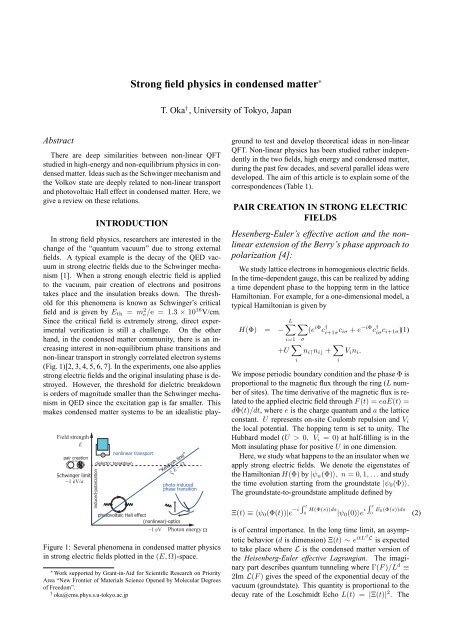Proceedings of International Conference on Physics in ... - KEK
Proceedings of International Conference on Physics in ... - KEK
Proceedings of International Conference on Physics in ... - KEK
Create successful ePaper yourself
Turn your PDF publications into a flip-book with our unique Google optimized e-Paper software.
Abstract<br />
Str<strong>on</strong>g field physics <strong>in</strong> c<strong>on</strong>densed matter ∗<br />
There are deep similarities between n<strong>on</strong>-l<strong>in</strong>ear QFT<br />
studied <strong>in</strong> high-energy and n<strong>on</strong>-equilibrium physics <strong>in</strong> c<strong>on</strong>densed<br />
matter. Ideas such as the Schw<strong>in</strong>ger mechanism and<br />
the Volkov state are deeply related to n<strong>on</strong>-l<strong>in</strong>ear transport<br />
and photovoltaic Hall effect <strong>in</strong> c<strong>on</strong>densed matter. Here, we<br />
give a review <strong>on</strong> these relati<strong>on</strong>s.<br />
INTRODUCTION<br />
In str<strong>on</strong>g field physics, researchers are <strong>in</strong>terested <strong>in</strong> the<br />
change <str<strong>on</strong>g>of</str<strong>on</strong>g> the “quantum vacuum” due to str<strong>on</strong>g external<br />
fields. A typical example is the decay <str<strong>on</strong>g>of</str<strong>on</strong>g> the QED vacuum<br />
<strong>in</strong> str<strong>on</strong>g electric fields due to the Schw<strong>in</strong>ger mechanism<br />
[1]. When a str<strong>on</strong>g enough electric field is applied<br />
to the vacuum, pair creati<strong>on</strong> <str<strong>on</strong>g>of</str<strong>on</strong>g> electr<strong>on</strong>s and positr<strong>on</strong>s<br />
takes place and the <strong>in</strong>sulati<strong>on</strong> breaks down. The threshold<br />
for this phenomena is known as Schw<strong>in</strong>ger’s critical<br />
field and is given by Eth = m 2 e/e = 1.3 × 10 16 V/cm.<br />
S<strong>in</strong>ce the critical field is extremely str<strong>on</strong>g, direct experimental<br />
verificati<strong>on</strong> is still a challenge. On the other<br />
hand, <strong>in</strong> the c<strong>on</strong>densed matter community, there is an <strong>in</strong>creas<strong>in</strong>g<br />
<strong>in</strong>terest <strong>in</strong> n<strong>on</strong>-equilibrium phase transiti<strong>on</strong>s and<br />
n<strong>on</strong>-l<strong>in</strong>ear transport <strong>in</strong> str<strong>on</strong>gly correlated electr<strong>on</strong> systems<br />
(Fig. 1)[2, 3, 4, 5, 6, 7]. In the experiments, <strong>on</strong>e also applies<br />
str<strong>on</strong>g electric fields and the orig<strong>in</strong>al <strong>in</strong>sulat<strong>in</strong>g phase is destroyed.<br />
However, the threshold for dielctric breakdown<br />
is orders <str<strong>on</strong>g>of</str<strong>on</strong>g> magnitude smaller than the Schw<strong>in</strong>ger mechanism<br />
<strong>in</strong> QED s<strong>in</strong>ce the excitati<strong>on</strong> gap is far smaller. This<br />
makes c<strong>on</strong>densed matter systems to be an idealistic play-<br />
Field strength<br />
E<br />
pair creati<strong>on</strong><br />
Schw<strong>in</strong>ger limit<br />
~1 eV/a<br />
<strong>in</strong>duced-polarizati<strong>on</strong><br />
V<br />
n<strong>on</strong>l<strong>in</strong>ear transport<br />
dielectric breakdown<br />
photovoltaic Hall effect<br />
(n<strong>on</strong>l<strong>in</strong>ear)-optics<br />
~1 eV Phot<strong>on</strong> energyΩ<br />
T. Oka † , University <str<strong>on</strong>g>of</str<strong>on</strong>g> Tokyo, Japan<br />
“Keldysh l<strong>in</strong>e”<br />
ξ E ~ Ω<br />
photo-<strong>in</strong>duced<br />
phase transiti<strong>on</strong><br />
Figure 1: Several phenomena <strong>in</strong> c<strong>on</strong>densed matter physics<br />
<strong>in</strong> str<strong>on</strong>g electric fields plotted <strong>in</strong> the (E, Ω)-space.<br />
∗ Work supported by Grant-<strong>in</strong>-Aid for Scientific Research <strong>on</strong> Priority<br />
Area “New Fr<strong>on</strong>tier <str<strong>on</strong>g>of</str<strong>on</strong>g> Materials Science Opened by Molecular Degrees<br />
<str<strong>on</strong>g>of</str<strong>on</strong>g> Freedom”.<br />
† oka@cms.phys.s.u-tokyo.ac.jp<br />
ground to test and develop theoretical ideas <strong>in</strong> n<strong>on</strong>-l<strong>in</strong>ear<br />
QFT. N<strong>on</strong>-l<strong>in</strong>ear physics has been studied rather <strong>in</strong>dependently<br />
<strong>in</strong> the two fields, high energy and c<strong>on</strong>densed matter,<br />
dur<strong>in</strong>g the past few decades, and several parallel ideas were<br />
developed. The aim <str<strong>on</strong>g>of</str<strong>on</strong>g> this article is to expla<strong>in</strong> some <str<strong>on</strong>g>of</str<strong>on</strong>g> the<br />
corresp<strong>on</strong>dences (Table 1).<br />
PAIR CREATION IN STRONG ELECTRIC<br />
FIELDS<br />
Hesenberg-Euler’s effective acti<strong>on</strong> and the n<strong>on</strong>l<strong>in</strong>ear<br />
extensi<strong>on</strong> <str<strong>on</strong>g>of</str<strong>on</strong>g> the Berry’s phase approach to<br />
polarizati<strong>on</strong> [4]:<br />
We study lattice electr<strong>on</strong>s <strong>in</strong> homogenious electric fields.<br />
In the time-dependent gauge, this can be realized by add<strong>in</strong>g<br />
a time dependent phase to the hopp<strong>in</strong>g term <strong>in</strong> the lattice<br />
Hamilt<strong>on</strong>ian. For example, for a <strong>on</strong>e-dimensi<strong>on</strong>al model, a<br />
typical Hamilt<strong>on</strong>ian is given by<br />
H(Φ) = −<br />
L∑ ∑<br />
i=1<br />
σ<br />
(e iΦ c †<br />
i+1σ ciσ + e −iΦ c †<br />
iσ ci+1σ)(1)<br />
+U ∑<br />
ni↑ni↓ + ∑<br />
V<strong>in</strong>i.<br />
i<br />
We impose periodic boundary c<strong>on</strong>diti<strong>on</strong> and the phase Φ is<br />
proporti<strong>on</strong>al to the magnetic flux through the r<strong>in</strong>g (L number<br />
<str<strong>on</strong>g>of</str<strong>on</strong>g> sites). The time derivative <str<strong>on</strong>g>of</str<strong>on</strong>g> the magnetic flux is related<br />
to the applied electric field through F (t) = eaE(t) =<br />
dΦ(t)/dt, where e is the charge quantum and a the lattice<br />
c<strong>on</strong>stant. U represents <strong>on</strong>-site Coulomb repulsi<strong>on</strong> and Vi<br />
the local potential. The hopp<strong>in</strong>g term is set to unity. The<br />
Hubbard model (U > 0, Vi = 0) at half-fill<strong>in</strong>g is <strong>in</strong> the<br />
Mott <strong>in</strong>sulat<strong>in</strong>g phase for positive U <strong>in</strong> <strong>on</strong>e dimensi<strong>on</strong>.<br />
Here, we study what happens to the an <strong>in</strong>sulator when we<br />
apply str<strong>on</strong>g electric fields. We denote the eigenstates <str<strong>on</strong>g>of</str<strong>on</strong>g><br />
the Hamilt<strong>on</strong>ian H(Φ) by |ψn(Φ)⟩, n = 0, 1, . . . and study<br />
the time evoluti<strong>on</strong> start<strong>in</strong>g from the groundstate |ψ0(Φ)⟩.<br />
The groundstate-to-groundstate amplitude def<strong>in</strong>ed by<br />
Ξ(t) ≡ ⟨ψ0(Φ(t))|e −i<br />
∫ t<br />
0 H(Φ(s))ds |ψ0(0)⟩e i<br />
∫ t<br />
0 E0(Φ(s))ds<br />
is <str<strong>on</strong>g>of</str<strong>on</strong>g> central importance. In the l<strong>on</strong>g time limit, an asymptotic<br />
behavior (d is dimensi<strong>on</strong>) Ξ(t) ∼ e itLd L is expected<br />
to take place where L is the c<strong>on</strong>densed matter versi<strong>on</strong> <str<strong>on</strong>g>of</str<strong>on</strong>g><br />
the Heisenberg-Euler effective Lagrangian. The imag<strong>in</strong>ary<br />
part describes quantum tunnel<strong>in</strong>g where Γ(F )/L d ≡<br />
2Im L(F ) gives the speed <str<strong>on</strong>g>of</str<strong>on</strong>g> the exp<strong>on</strong>ential decay <str<strong>on</strong>g>of</str<strong>on</strong>g> the<br />
vacuum (groundstate). This quantity is proporti<strong>on</strong>al to the<br />
decay rate <str<strong>on</strong>g>of</str<strong>on</strong>g> the Loschmidt Echo L(t) = |Ξ(t)| 2 . The<br />
i<br />
(2)













